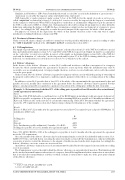Page 463 - SAIT Compendium 2016 Volume2
P. 463
IN 48 (2) Income Tax acT: InTeRPReTaTIon noTes IN 48 (2)
Similarly, in Geldenhuys v CIR* Steyn J stated that the words ‘received by’ as used in the de nition of ‘gross income’ – ‘must mean ‘received by the taxpayer on his own behalf for his own bene t’ ‘.
VAT charged by a vendor (taxpayer) under section 7(1)(a) of the VAT Act for the supply of goods or services (so-
called ‘output tax’ as de ned in section 1(1) of that Act), is not received by the taxpayer on the taxpayer’s own behalf for the taxpayer’s own bene t. When VAT is charged by a vendor there is an immediate obligation to pay the amount of the VAT so collected to SARS at a future date. Such payment is effected by setting off any input tax or other allowable deductions and paying the balance to SARS. In these circumstances output tax does not form part of a taxpayer’s ‘gross income’. Accordingly, the VAT charged by a vendor does not form part of the expression ‘the whole of that amount’.
For purposes of section 24, the expression ‘the whole of that amount’ therefore refers to the sum total of capital instalments excluding both nance charges and VAT.
4.2 Treatment of nance charges
Under section 24J, nance charges are subject to normal tax over the period in which they are earned according to either the ‘yield to maturity’ method or the ‘alternative method’ as de ned in section 24J(1).
4.3 VAT implications
The supply of goods under an ‘instalment credit agreement’ as de ned in section 1(1) of the VAT Act is subject to special time and valuation rules under sections 9(3)(c) and 10(6) of the VAT Act respectively. Output tax must be accounted for on the ‘cash value’ received or receivable in respect of the supply (as determined under section 10(6) of the VAT Act read with the de nition of ‘cash value’) in the tax period under section 27 of the VAT Act during which the goods are delivered, or consideration is received [refer to section 9(3)(c)], whichever is the earliest.
4.4 Debtors’ allowance
In the absence of the debtors’ allowance, section 24(1) could result in adverse cash- ow consequences for a taxpayer because the whole amount under the agreement is deemed to accrue up front, while the instalments may only be receivable over an extended period. A taxpayer might, therefore, not have received suf cient cash to settle the normal tax on the gross pro t.
Under section 24(1) the debtors’ allowance is granted to taxpayers only in cases in which the passing of ownership of the property sold is subject to a suspensive condition, namely, payment of the whole or a certain portion of the selling price.
In addition, section 24(2) provides that at least 25% of the whole of the amount under the agreement must be due and payable at least 12 months after conclusion of the agreement before the debtors’ allowance may be granted. For this purpose, any deposit payable is regarded as a payment of a portion of the selling price within the rst 12 months.
Example 1 – Determination of whether 25% of the selling price is payable at least 12 months after an instalment credit agreement is entered into
Facts:
On 1 June 2014 XYZ Ltd sold a second-hand stove to C for R1000 under an instalment credit agreement. A deposit of R400 was payable on signature of the agreement and the remaining R600 was payable in 30 monthly instalments of R20 each, which are due on the rst day of each month commencing 1 July 2014. Determine whether the agreement meets the 25% requirement in section 24(2). Ignore nance charges for the purposes of the example.
Result:
Before 31 May 2015 (12 months after the agreement was entered into) C is required to pay a deposit of R400 plus 11 instalments of R20 each.
R Selling price 1000
Less:
Deposit (400) Less: Instalments payable within rst 12 months (11 × R20) (220) Selling price payable at least 12 months after agreement signed 380
Since 38% (R380 / R1000 × 100) of the selling price is payable at least 12 months after the agreement, the agreement meets the 25% requirement.
Once the amount of the debtors’ allowance has been determined under section 24 it is deductible under section 11(x). In ITC 1697† the court held that in exercising the discretion under section 24C the Commissioner could not arbitrarily as a matter of practice restrict the allowance to the amount of taxable income from the trade in question. Accordingly the debtors’ allowance can create or increase an assessed loss.
Any debtors’ allowance claimed in a year of assessment must be added back to the taxpayer’s income in the succeeding year of assessment.
The Commissioner reserves the right to limit the debtors’ allowance on any particular transaction. This limitation will not be invoked in normal business transactions of a taxpayer, but will be implemented when a transaction is entered into that is not related to normal business activities or when a scheme is entered into to make use of the gross pro t element of the debtors’ allowance.
* 1947 (3) SA 256 (C),14 SATC 419 at 430. † (1999) 63 SATC 146 (N).
saIT comPendIum oF Tax LegIsLaTIon VoLume 2 455


